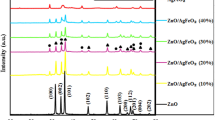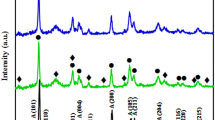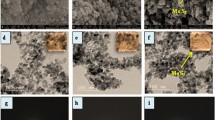Abstract
Achieving hydrogen production and simultaneous decomposition of organic pollutants through dual-functional photocatalytic reactions has received increasing attention due to the environmentally friendly and cost-effective characteristics of this approach. In this work, an urchin-like oxygen-doped MoS2/ZnIn2S4 (OMS/ZIS) composite was fabricated for the first time using a simple solvothermal method. The unique microstructure with abundant active sites and fast charge transfer channels further shortened the charge migration distance and compressed carrier recombination. The obtained composite exhibited an efficient H2 evolution reaction rate of 12.8 mmol/g/h under visible light, which was nearly times higher than pristine ZnIn2S4, and the apparent quantum efficiency was 14.9% (420 nm). The results of the simultaneous photocatalytic H2 evolution and organic pollutant decomposition test were satisfactory, resulting in decomposition efficiencies of resorcinol, tetracycline, and bisphenol A that reached 41.5%, 63.5%, and 53.0% after 4 h, respectively, and the highest H2 evolution rate was 672.7 µmol/g/h for bisphenol A. Furthermore, natural organic matter (NOM) abundantly found in actual water was adopted as an electron donor for H production under simulated sunlight irradiation, indicating the promising practicability of simultaneous hydrogen evolution and NOM decomposition. Moreover, the mechanisms of the dual-purpose photocatalytic reactions, as well as the synergistic effect between the molecular structures of the organic pollutants and the corresponding adsorption behavior on the photocatalyst surface were illustrated in detail. These obtained results may serve as an inspiration for the rational design of highly efficient, dual-functional photocatalysts in the future.

Similar content being viewed by others
References
Byskov L S, Nørskov J K, Clausen B S, Topsøe H (1999). DFT calculations of unpromoted and promoted MoS2-based hydrodesulfurization catalysts. Journal of Catalysis, 187(1): 109–122
Chai B, Liu C, Wang C, Yan J, Ren Z (2017). Photocatalytic hydrogen evolution activity over MoS2/ZnIn2S4 microspheres. Chinese Journal of Catalysis, 38(12): 2067–2075
Chandrasekaran S, Yao L, Deng L, Bowen C, Zhang Y, Chen S, Lin Z, Peng F, Zhang P (2019). Recent advances in metal sulfides: from controlled fabrication to electrocatalytic, photocatalytic and photoelectrochemical water splitting and beyond. Chemical Society Reviews, 48(15): 4178–4280
Chen G, Ding N, Li F, Fan Y, Luo Y, Li D, Meng Q (2014). Enhancement of photocatalytic H2 evolution on ZnIn2S4 loaded with in-situ photo-deposited MoS2 under visible light irradiation. Applied Catalysis B: Environmental, 160–161: 614–620
Chen S, Li S, Xiong L, Wang G (2018). In-situ growth of ZnIn2S4 decorated on electrospun TiO2 nanofibers with enhanced visible-light photocatalytic activity. Chemical Physics Letters, 706: 68–75
Cho Y J, Moon G H, Kanazawa T, Maeda K, Choi W (2016). Selective dual-purpose photocatalysis for simultaneous H2 evolution and mineralization of organic compounds enabled by a Cr2O3 barrier layer coated on Rh/SrTiO3. Chemical Communications, 52(62): 9636–9639
Daskalaki V M, Antoniadou M, Li Puma G, Kondarides D I, Lianos P (2010). Solar light-responsive Pt/CdS/TiO2 photocatalysts for hydrogen production and simultaneous degradation of inorganic or organic sacrificial agents in wastewater. Environmental Science & Technology, 44(19): 7200–7205
Ding N, Fan Y, Luo Y, Li D, Meng Q (2015). Enhancement of H2 evolution over new ZnIn2S4/RGO/MoS2 photocatalysts under visible light. APL Materials, 3(10): 104417
Du C, Zhang Q, Lin Z, Yan B, Xia C, Yang G (2019). Half-unit-cell ZnIn2S4 monolayer with sulfur vacancies for photocatalytic hydrogen evolution. Applied Catalysis B: Environmental, 248: 193–201
Eisenstein M (2015). Pesticides: Seeking answers amid a toxic debate. Nature, 521(7552): S52–S55
Gao B, Du X, Ma Y, Li Y, Li Y, Ding S, Song Z, Xiao C (2020). 3D flower-like defected MoS2 magnetron-sputtered on candle soot for enhanced hydrogen evolution reaction. Applied Catalysis B: Environmental, 263: 117750
Guan Z, Wang P, Li Q, Li G, Yang J (2018). Constructing a ZnIn2S4 nanoparticle/MoS2-RGO nanosheet 0D/2D heterojunction for significantly enhanced visible-light photocatalytic H2 production. Dalton Transactions (Cambridge, England), 47(19): 6800–6807
Hao M, Deng X, Xu L, Li Z (2019). Noble metal free MoS2/ZnIn2S4 nanocomposite for acceptorless photocatalytic semi-dehydrogenation of 1,2,3,4-tetrahydroisoquinoline to produce 3,4-dihydroisoquinoline. Applied Catalysis B: Environmental, 252: 18–23
Hou Y, Laursen A B, Zhang J, Zhang G, Zhu Y, Wang X, Dahl S, Chorkendorff I (2013). Layered nanojunctions for hydrogen-evolution catalysis. Angewandte Chemie International Edition, 52(13): 3621–3625
Hu P, Su H, Chen Z, Yu C, Li Q, Zhou B, Alvarez P J J, Long M (2017). Selective degradation of organic pollutants using an efficient metal-free catalyst derived from carbonized polypyrrole via peroxymonosulfate activation. Environmental Science & Technology, 51(19): 11288–11296
Huang T, Chen W, Liu T Y, Hao Q L, Liu X H (2017). ZnIn2S4 hybrid with MoS2: A non-noble metal photocatalyst with efficient photocatalytic activity for hydrogen evolution. Powder Technology, 315: 157–162
Jiang G, Wang K, Li J, Fu W, Zhang Z, Johnson G, Lv X, Zhang Y, Zhang S, Dong F (2018a). Electrocatalytic hydrodechlorination of 2,4-dichlorophenol over palladium nanoparticles and its pH-mediated tug-of-war with hydrogen evolution. Chemical Engineering Journal, 348: 26–34
Jiang X H, Wang L C, Yu F, Nie Y C, Xing Q J, Liu X, Pei Y, Zou J P, Dai W L (2018b). Photodegradation of organic pollutants coupled with simultaneous photocatalytic evolution of hydrogen using quantum-dot-modified g-C3N4 catalysts under visible-light irradiation. ACS Sustainable Chemistry & Engineering, 6(10): 12695–12705
Jo W K, Natarajan T S (2016). Fabrication and efficient visible light photocatalytic properties of novel zinc indium sulfide (ZnIn2S4) − graphitic carbon nitride (g-C3N4)/bismuth vanadate (BiVO4) nanorod-based ternary nanocomposites with enhanced charge separation via Z-scheme transfer. Journal of Colloid and Interface Science, 482: 58–72
Kampouri S, Nguyen T N, Spodaryk M, Palgrave R G, Züttel A, Smit B, Stylianou K C (2018). Concurrent photocatalytic hydrogen generation and dye degradation using MIL − 125 − NH2 under visible light irradiation. Advanced Functional Materials, 28(52): 1806368
Kampouri S, Stylianou K C (2019). Dual-functional photocatalysis for simultaneous hydrogen production and oxidation of organic substances. ACS Catalysis, 9(5): 4247–4270
Li T, Zhong W, Jing C, Li X, Zhang T, Jiang C, Chen W (2020). Enhanced hydrolysis of p-nitrophenyl phosphate by iron (hydr) oxide nanoparticles: Roles of exposed facets. Environmental Science & Technology, 54(14): 8658–8667
Li W, Lin Z, Yang G (2017). A 2D self-assembled MoS2/ZnIn2S4 heterostructure for efficient photocatalytic hydrogen evolution. Nanoscale, 9(46): 18290–18298
Li Y, Lu G, Li S (2001). Photocatalytic hydrogen generation and decomposition of oxalic acid over platinized TiO2. Applied Catalysis A, General, 214(2): 179–185
Lin Z, Li L, Yu L, Li W, Yang G (2017). Dual-functional photocatalysis for hydrogen evolution from industrial wastewaters. Physical Chemistry Chemical Physics, 19(12): 8356–8362
Liu C, Wang L, Tang Y, Luo S, Liu Y, Zhang S, Zeng Y, Xu Y (2015). Vertical single or few-layer MoS2 nanosheets rooting into TiO2 nanofibers for highly efficient photocatalytic hydrogen evolution. Applied Catalysis B: Environmental, 164: 1–9
Liu H, Zhang J, Ao D (2018a). Construction of heterostructured ZnIn2S4@NH2−MIL−125(Ti) nanocomposites for visible-light-driven H2 production. Applied Catalysis B: Environmental, 221: 433–442
Liu J, Fang W, Wei Z, Qin Z, Jiang Z, Shangguan W (2018b). Metallic 1T−LixMoS2 co-catalyst enhanced photocatalytic hydrogen evolution over ZnIn2S4 floriated microspheres under visible light irradiation. Catalysis Science & Technology, 8(5): 1375–1382
Liu K H, Zhong H X, Li S J, Duan Y X, Shi M M, Zhang X B, Yan J M, Jiang Q (2018c). Advanced catalysts for sustainable hydrogen generation and storage via hydrogen evolution and carbon dioxide/nitrogen reduction reactions. Progress in Materials Science, 92: 64–111
Ma J, Wang H, Liu X, Lu L, Nie L, Yang X, Chai Y, Yuan R (2017). Synthesis of tube shape MnO/Cp composite from 3,4,9,10-perylenetetracarboxylic dianhydride for lithium ion batteries. Chemical Engineering Journal, 309: 545–551
Maqbool T, Qin Y, Ly Q V, Zhang J, Li C, Asif M B, Zhang Z (2020). Exploring the relative changes in dissolved organic matter for assessing the water quality of full-scale drinking water treatment plants using a fluorescence ratio approach. Water Research, 183: 116125
Mo Z, Xu H, Chen Z, She X, Song Y, Wu J, Yan P, Xu L, Lei Y, Yuan S, Li H (2018). Self-assembled synthesis of defect-engineered graphitic carbon nitride nanotubes for efficient conversion of solar energy. Applied Catalysis B: Environmental, 225: 154–161
Nie Y C, Yu F, Wang L C, Xing Q J, Liu X, Pei Y, Zou J P, Dai W L, Li Y, Suib S L (2018). Photocatalytic degradation of organic pollutants coupled with simultaneous photocatalytic H2 evolution over graphene quantum dots/Mn−N−TiO2/g−C3N4 composite catalysts: performance and mechanism. Applied Catalysis B: Environmental, 227: 312–321
Patsoura A, Kondarides D I, Verykios X E (2006). Enhancement of photoinduced hydrogen production from irradiated Pt/TiO2 suspensions with simultaneous degradation of azo-dyes. Applied Catalysis B: Environmental, 64(3–4): 171–179
Sun N, Qu Y, Yang C, Yang Z, Yan R, E W, Zhang Z, Li Z, Li H, Khan I (2020). Efficiently photocatalytic degradation of monochlorophenol on in-situ fabricated BiPO4/β-Bi2O3 heterojunction microspheres and O2-free hole-induced selective dechloridation conversion with H2 evolution. Applied Catalysis B: Environmental, 263: 118313
Swain G, Sultana S, Parida K (2019). One-pot-architectured Au-nanodot-promoted MoS2/ZnIn2S4: A novel p−n heterojunction photocatalyst for enhanced hydrogen production and phenol degradation. Inorganic Chemistry, 58(15): 9941–9955
Tang Y J, Wang Y, Wang X L, Li S L, Huang W, Dong L Z, Liu C H, Li Y F, Lan Y Q (2016). Molybdenum disulfide/nitrogen-doped reduced graphene oxide nanocomposite with enlarged interlayer spacing for electrocatalytic hydrogen evolution. Advanced Energy Materials, 6(12): 1600116
Tian G, Chen Y, Ren Z, Tian C, Pan K, Zhou W, Wang J, Fu H (2014). Enhanced photocatalytic hydrogen evolution over hierarchical composites of ZnIn2S4 nanosheets grown on MoS2 slices. Chemistry, An Asian Journal, 9(5): 1291–1297
Wan S, Ou M, Zhong Q, Zhang S, Song F (2017). Construction of Z-scheme photocatalytic systems using ZnIn2S4, CoOx-loaded Bi2MoO6 and reduced graphene oxide electron mediator and its efficient nonsacrificial water splitting under visible light. Chemical Engineering Journal, 325: 690–699
Wang H, Wu Y, Feng M, Tu W, Xiao T, Xiong T, Ang H, Yuan X, Chew J W (2018a). Visible-light-driven removal of tetracycline antibiotics and reclamation of hydrogen energy from natural water matrices and wastewater by polymeric carbon nitride foam. Water Research, 144: 215–225
Wang Q, Huang J, Sun H, Ng Y H, Zhang K Q, Lai Y (2018b). MoS2 quantum dots@TiO2 nanotube arrays: An extended-spectrum-driven photocatalyst for solar hydrogen evolution. ChemSusChem, 11(10): 1708–1721
Wang S, Zhu B, Liu M, Zhang L, Yu J, Zhou M (2019). Direct Z-scheme ZnO/CdS hierarchical photocatalyst for enhanced photocatalytic H2-production activity. Applied Catalysis B: Environmental, 243: 19–26
Wei L, Chen Y, Lin Y, Wu H, Yuan R, Li Z (2014). MoS2 as non-noble-metal co-catalyst for photocatalytic hydrogen evolution over hexagonal ZnIn2S4 under visible light irradiations. Applied Catalysis B: Environmental, 144: 521–527
Wei Z, Liu J, Fang W, Xu M, Qin Z, Jiang Z, Shangguan W (2019). Photocatalytic hydrogen evolution with simultaneous antibiotic wastewater degradation via the visible-light-responsive bismuth spheres-g-C3N4 nanohybrid: Waste to energy insight. Chemical Engineering Journal, 358: 944–954
Wu Z, Liu X, Liu J, Liu S, Zha Z, Chen Z (2019). Molybdenum disulfide based composites and their photocatalytic degradation and hydrogen evolution properties. Progress in Chemistry, 31(8): 1086–1102 (in Chinese)
Xiao X, Hao R, Liang M, Zuo X, Nan J, Li L, Zhang W (2012). One-pot solvothermal synthesis of three-dimensional (3D) BiOI/BiOCl composites with enhanced visible-light photocatalytic activities for the degradation of bisphenol-A. Journal of Hazardous Materials, 233–234: 122–130
Xu Y, Yan A, Jiang L, Huang F, Hu D, Duan G, Zheng F (2022). MoS2/HCSs/ZnIn2S4 nanocomposites with enhanced charge transport and photocatalytic hydrogen evolution performance. Journal of Alloys and Compounds, 895: 162504
Yang G, Ding H, Chen D, Feng J, Hao Q, Zhu Y (2018). Construction of urchin-like ZnIn2S4−Au−TiO2 heterostructure with enhanced activity for photocatalytic hydrogen evolution. Applied Catalysis B: Environmental, 234: 260–267
Yi H, Huang D, Qin L, Zeng G, Lai C, Cheng M, Ye S, Song B, Ren X, Guo X (2018). Selective prepared carbon nanomaterials for advanced photocatalytic application in environmental pollutant treatment and hydrogen production. Applied Catalysis B: Environmental, 239: 408–424
Yuan Y J, Chen D, Zhong J, Yang L X, Wang J, Liu M J, Tu W G, Yu Z T, Zou Z G (2017). Interface engineering of a noble-metal-free 2D−2D MoS2/Cu−ZnIn2S4 photocatalyst for enhanced photocatalytic H2 production. Journal of Materials Chemistry. A, Materials for Energy and Sustainability, 5(30): 15771–15779
Yuan Y J, Tu J R, Ye Z J, Chen D Q, Hu B, Huang Y W, Chen T T, Cao D P, Yu Z T, Zou Z G (2016). MoS2-graphene/ZnIn2S4 hierarchical microarchitectures with an electron transport bridge between light-harvesting semiconductor and cocatalyst: A highly efficient photocatalyst for solar hydrogen generation. Applied Catalysis B: Environmental, 188: 13–22
Zhang G, Chen D, Li N, Xu Q, Li H, He J, Lu J (2020). Construction of hierarchical hollow Co9S8/ZnIn2S4 tubular heterostructures for highly efficient solar energy conversion and environmental remediation. Angewandte Chemie, 132(21): 8332–8338
Zhang S, Gu P, Ma R, Luo C, Wen T, Zhao G, Cheng W, Wang X (2019). Recent developments in fabrication and structure regulation of visible-light-driven g-C3N4-based photocatalysts towards water purification: A critical review. Catalysis Today, 335: 65–77
Zhang S, Liu X, Liu C, Luo S, Wang L, Cai T, Zeng Y, Yuan J, Dong W, Pei Y, Liu Y (2018a). MoS2 quantum dot growth induced by S vacancies in a ZnIn2S4 monolayer: atomic-level heterostructure for photocatalytic hydrogen production. ACS Nano, 12(1): 751–758
Zhang S, Wang L, Liu C, Luo J, Crittenden J, Liu X, Cai T, Yuan J, Pei Y, Liu Y (2017). Photocatalytic wastewater purification with simultaneous hydrogen production using MoS2 QD-decorated hierarchical assembly of ZnIn2S4 on reduced graphene oxide photocatalyst. Water Research, 121: 11–19
Zhang X H, Li N, Wu J, Zheng Y Z, Tao X (2018b). Defect-rich O-incorporated 1T−MoS2 nanosheets for remarkably enhanced visible-light photocatalytic H2 evolution over CdS: The impact of enriched defects. Applied Catalysis B: Environmental, 229: 227–236
Zhang Z, Huang L, Zhang J, Wang F, Xie Y, Shang X, Gu Y, Zhao H, Wang X (2018c). In situ constructing interfacial contact MoS2/ZnIn2S4 heterostructure for enhancing solar photocatalytic hydrogen evolution. Applied Catalysis B: Environmental, 233: 112–119
Zhao T, Xing Z, Xiu Z, Li Z, Yang S, Zhou W (2019). Oxygen-doped MoS2 nanospheres/CdS quantum dots/g-C3N4 nanosheets superarchitectures for prolonged charge lifetime and enhanced visible-light-driven photocatalytic performance. ACS Applied Materials & Interfaces, 11(7): 7104–7111
Acknowledgements
This study was supported by the National Key Scientific Instrument and Equipment Development Project of China (No. 21627809), the National Natural Science Foundation of China (No. 21777056), the Natural Science Foundation of Shandong Province (China) (Nos. ZR2020MB091 and ZR2020MB037), the Youth Innovative Talents Recruitment and Cultivation Program of Shandong Higher Education (China), and the Jinan Scientific Research Leader Workshop Project (China) (No. 2018GXRC021).
Author information
Authors and Affiliations
Corresponding authors
Additional information
Highlights
• An urchin-like OMS/ZIS composite was fabricated by a facile solvothermal method.
• The OMS/ZIS exhibits superior photocatalytic H2 evolution for organics degradation.
• A probable mechanism of dual-functional photocatalysis was proposed in detail.
• This work provides an inspiration for rational design of dual-functional catalysts.
Supplementary Material
11783_2022_1566_MOESM1_ESM.pdf
Highly effective visible-photocatalytic hydrogen evolution and simultaneous organic pollutant degradation over an urchin-like oxygen-doped MoS2/ZnIn2S4 composite
Rights and permissions
About this article
Cite this article
Yan, T., Yang, Q., Feng, R. et al. Highly effective visible-photocatalytic hydrogen evolution and simultaneous organic pollutant degradation over an urchin-like oxygen-doped MoS2/ZnIn2S4 composite. Front. Environ. Sci. Eng. 16, 131 (2022). https://doi.org/10.1007/s11783-022-1566-z
Received:
Revised:
Accepted:
Published:
DOI: https://doi.org/10.1007/s11783-022-1566-z




